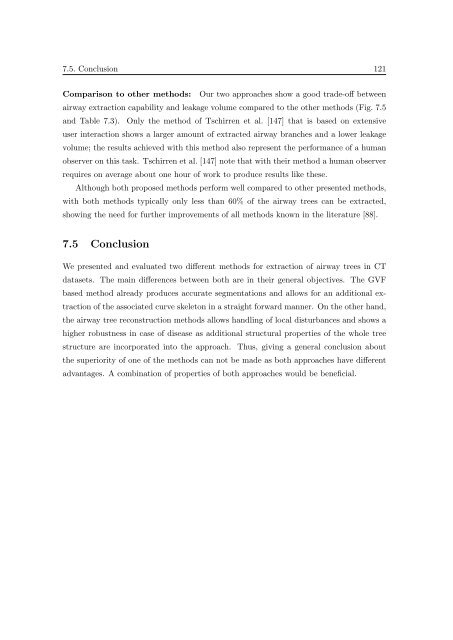Segmentation of 3D Tubular Tree Structures in Medical Images ...
Segmentation of 3D Tubular Tree Structures in Medical Images ...
Segmentation of 3D Tubular Tree Structures in Medical Images ...
You also want an ePaper? Increase the reach of your titles
YUMPU automatically turns print PDFs into web optimized ePapers that Google loves.
7.5. Conclusion 121<br />
Comparison to other methods: Our two approaches show a good trade-<strong>of</strong>f between<br />
airway extraction capability and leakage volume compared to the other methods (Fig. 7.5<br />
and Table 7.3). Only the method <strong>of</strong> Tschirren et al. [147] that is based on extensive<br />
user <strong>in</strong>teraction shows a larger amount <strong>of</strong> extracted airway branches and a lower leakage<br />
volume; the results achieved with this method also represent the performance <strong>of</strong> a human<br />
observer on this task. Tschirren et al. [147] note that with their method a human observer<br />
requires on average about one hour <strong>of</strong> work to produce results like these.<br />
Although both proposed methods perform well compared to other presented methods,<br />
with both methods typically only less than 60% <strong>of</strong> the airway trees can be extracted,<br />
show<strong>in</strong>g the need for further improvements <strong>of</strong> all methods known <strong>in</strong> the literature [88].<br />
7.5 Conclusion<br />
We presented and evaluated two different methods for extraction <strong>of</strong> airway trees <strong>in</strong> CT<br />
datasets. The ma<strong>in</strong> differences between both are <strong>in</strong> their general objectives. The GVF<br />
based method already produces accurate segmentations and allows for an additional extraction<br />
<strong>of</strong> the associated curve skeleton <strong>in</strong> a straight forward manner. On the other hand,<br />
the airway tree reconstruction methods allows handl<strong>in</strong>g <strong>of</strong> local disturbances and shows a<br />
higher robustness <strong>in</strong> case <strong>of</strong> disease as additional structural properties <strong>of</strong> the whole tree<br />
structure are <strong>in</strong>corporated <strong>in</strong>to the approach. Thus, giv<strong>in</strong>g a general conclusion about<br />
the superiority <strong>of</strong> one <strong>of</strong> the methods can not be made as both approaches have different<br />
advantages. A comb<strong>in</strong>ation <strong>of</strong> properties <strong>of</strong> both approaches would be beneficial.















